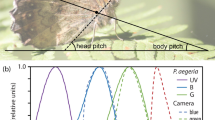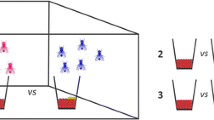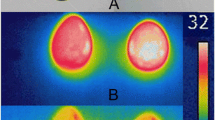Abstract
Tandem oviposition, where males guide females in contact, requires quite a substantial muscle activity from males and, therefore, stronger heat production within the male thorax compared to the female thorax. In the present study, an infrared camera equipped with a macrolens was applied in the field, in order to estimate temperature in different body regions of male and female dragonflies Sympetrum vulgatum laying eggs in tandems. In both sexes, the thorax was considerably warmer than other body parts. The male thorax was on average 3–4 °C warmer than that of the female. These observations support previous data that Sympetrum males have a stronger muscular activity and heat production in tandem during the egg-laying process compared to females. The data provide additional evidence that this kind of contact guarding behavior during oviposition is rather costly for males. The tip of the male abdomen was much warmer than its own abdomen in the middle region. This result might be explained by possible heat transfer from the female head to the male abdomen through the contact between male abdominal appendages and the female head. An alternative explanation might be strong activity of the muscles controlling male anal appendages. Finally, this study also demonstrated a strong potential of IR cameras in field studies of dragonfly behavioral physiology.



Similar content being viewed by others
References
Corbet PS (1999) Dragonflies: behaviour and ecology of Odonata. Harley Books, Colchester
Gallego B, Verdú JR, Carrascal LM, Lobo JM (2016) A protocol for analyzing thermal stress in insects using infrared thermography. J Thermal Biol 56:113–121
Gallego B, Verdú JR, Carrascal LM, Lobo JM (2017) Thermal tolerance and recovery behaviour of Thorectes lusitanicus (Coleoptera, Geotrupidae). Ecol Entomol 42:758–767. https://doi.org/10.1111/een.12447
Gorb SN (2000) Ultrastructure of the neck membrane in dragonflies (Odonata). J Zool Lond 250:479–494
Heinrich B (1993) The hot-blooded insects: strategies and mechanisms of thermoregulation. Harvard University Press, Cambridge
Heinrich B, Casey TM (1978) Heat transfer in dragonflies: “fliers” and “perchers”. J Exp Biol 74:17–36
Ishizawa N (1998) Thermoregulation in Sympetrum frequens (Selys), with notes on other Sympetrum species (Anisoptera: Libellulidae). Odonatologica 27:317–334
Kolev E, Gorb SN, Schilling C, Riemer D (2001) Ein Kopf-Kühlsystem bei Libellen (Odonata)? (Head cooling system in dragonflies (Odonata)?). In: Wisser A, Nachtigall W (eds) In Technische Biologie und Bionik, 5. Bionik-Kongress, Dessau 2000. Stuttgart, Jena, Lübeck, Ulm, Gustav Fisher Verlag, pp 317–322
May ML (1976) Thermoregulation and adaptation to temperature in dragonflies (Odonata: Anisoptera). Ecol Monogr 46:1–32
May ML (1995a) Simultaneous control of head and thoracic temperature by the green darner dragonfly Anax junius (Odonata: Aeshnidae). J Exp Biol 198:2373–2384
May ML (1995b) Dependence of flight behavior and heat production on air temperature in the green darner dragonfly Anax junius (Odonata: Aeshnidae). J Exp Biol 198:2385–2392
May ML (2017) Body temperature regulation in the dragonfly, Arigomphus villosipes (Odonata: Anisoptera: Gomphidae). Int J Odonatol 20:151–163. https://doi.org/10.1080/13887890.2017.1346523
Sformo T, Doak P (2006) Thermal ecology of interior Alaska dragonflies (Odonata: Anisoptera). Funct Ecol 20:114–123
Singer F (1987) A physiological basis of variation in post-copulatory behaviour in a dragonfly Sympterum obtrusum. Anim Behav 35:1575–1577
Stabentheiner A, Kovac H, Hetz SK, Käfer H, Stabentheiner G (2012) Assessing honeybee and wasp thermoregulation and energetics — new insights by combination of flow-through respirometry with infrared thermography. Thermochim Acta 534:77–86
Tracy CR, Tracy BJ, Dobkin DS (1979) The role of posturing in behavioral thermoregulation by Black Dragons (Hagenius brevistylus Selys; Odonata). Physiol Biochem Zool 52:565–571
Watanabe M, Matsuoka H, Susa K, Taguchi M (2005) Thoracic temperature in Sympetrum infuscatum (Selys) in relation to habitat and activity (Anisoptera: Libellulidae). Odonatologica 34:271–283
Data accessibility
Data are available in the Supplementary Table S1.
Funding
This study was partly supported by funds from Kiel University.
Author information
Authors and Affiliations
Contributions
S.N.G. and E.V.G. conceived the work. S.N.G. collected experimental data. E.V.G. analyzed the data and prepared the figures. S.N.G. wrote the draft manuscript. All authors approved the final version.
Corresponding author
Ethics declarations
Ethics
The work was undertaken with ethical approval of the Kiel University, Germany.
Competing interests
The authors declare that they have no competing interests.
Additional information
Communicated by: Matthias Waltert
Publisher’s note
Springer Nature remains neutral with regard to jurisdictional claims in published maps and institutional affiliations.
Electronic supplementary material
Table S1
from Egg-laying job makes males hot: Body temperature measurements in egg-lying tandems of the dragonfly Sympetrum vulgatum using IR camera. Summary of the temperatures (°C) of the thorax, head, and abdomen in males and females from ovipositing Sympetrum sanguineum tandems and background objects (surrounding). (XLSX 11 kb)
Rights and permissions
About this article
Cite this article
Gorb, S.N., Gorb, E.V. Egg-laying job makes males hot: body temperature measurements in egg-laying tandems of the dragonfly Sympetrum vulgatum using IR camera. Sci Nat 106, 40 (2019). https://doi.org/10.1007/s00114-019-1639-4
Received:
Revised:
Accepted:
Published:
DOI: https://doi.org/10.1007/s00114-019-1639-4




